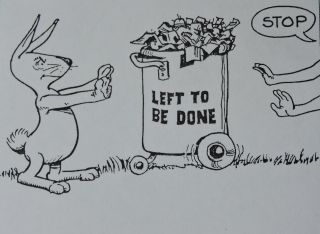Procrastination
Do This One Thing and Stop Procrastinating
Directly substitute purposeful actions for procrastination diversions.
Posted October 16, 2014
Procrastination is a huge barrier to getting daily things done as well as performing at high levels. This impediment surfaces in different ways, such as hesitating, holding back, and getting involved in self-sabotaging distractions. Fortunately, you can do much to turn things around for yourself, to feel better about yourself, and to enjoy your accomplishments.
It’s Not Complicated
Getting things done is not complicated. You make up your mind to do what you need to do now, whether it’s filling out a form, cleaning your residence, or stopping yourself from stressing out. You start. You chip away. You finish or make strides in the right direction.
When you procrastinate, your life quickly gets complicated; that is partially because procrastination is complicated. To avoid an uncomfortable activity, you may befuddle yourself by delaying until there is figuratively hell to pay. For example, you may emotionally connect a pending activity to discomfort, uncertainty, or inconvenience. You may default to doing something less threatening. You may magically justify delaying by planning to start and finish at some indefinite time in the future. Other than putting yourself into a difficult situation, where does that get you?
Watch Out for Sidetracking
You have a priority responsibility for meeting a deadline, or for helping yourself with a self-improvement activity like overcoming a social anxiety. When you procrastinate, you do something different. That’s it!
Sidetracking is what makes procrastination, procrastination. You can practically always find something more appealing to do than what you feel tempted to delay. You can play computer games or dream about immediate successes. You can drive to the country to get your mind off your worries and troubles about delaying. As you do these things, you fall further behind.
Let’s address the main feature of procrastination. Here’s a question to spotlight this issue: “What do I do when I procrastinate?” Among a list of procrastination activities, inevitably you’ll find that you engage in safer, easier, or temporarily more pleasing activities.
Turn Things Around for Yourself
Can you stop frittering your valuable time on discretionary activities? You can if you get back to doing what is less complicated and avoid the rush to catch up as the clock winds down. In the process, you may find that not only can you get the more unpleasant tasks off your back, but also you’ll have a lot of extra time to do what is meaningful and for doing what is fun. (As the adage goes, "All work and no play makes Jack a dull boy." Who wants to feel and act dull? Keeping your nose to the grindstone can do that.)
When you procrastinate, you always do something less pressing and important. These diversions are the sine qua non, or the critical distinguishing feature of procrastination.
In the natural world, you can’t eliminate a wired-in tendency to avoid what is uncomfortable and to approach what is safe. However, you live in a social world where many things are different. In this world, procrastination is common, costly, and ordinarily worth quelling.
You can’t eliminate your natural world impulses. You can control procrastination that may arise from them. For example, before you get too far along in a procrastination cycle, you can act to eliminate time-wasting distractions, such as looking glassy-eyed at a TV screen or walking in circles carrying on a philosophical discussion with yourself about the meaning of life.
If distracting yourself isn’t working for you, you have other choices. Here are two quick tips for eliminating the sine qua non of procrastination:
- Maintain perspective. By exercising your power of foresight, you may anticipate when procrastination can kick in and act to avoid it. By assessing the time costs of a distraction, you may find that it is to your advantage to switch quickly from sidetracking to productive actions. Here’s how to strengthen this productive perspective: (1) Start with a short-term\long-term cost benefits analysis where you compare diversionary actions versus directly doing a priority activity. (2) If you agree that there is little to gain by diverting yourself, visualize the action steps you’ll take to attack the productive activity. (3) Do what you visualize. (4) Resist the temptation to sidetrack to something else, and if you do, remind yourself to pause for a moment, consider the virtues of finishing, and then get back on track.
- Monitor what you do when you procrastinate. Observing and monitoring your procrastination cycle is an important part of voluntary self-change. Diversions rob time from productive activities, and are prime targets for the sort of observations that are preludes to positive changes. (Observing and measuring what you do, is a time-tested way of setting the stage for changing a dysfunctional process.1,2) Here is an experiment for you to test this idea. (1) Pick one area where you are already procrastinating. For example, you have a report due in two weeks and you are already working up excuses in your mind to put it off. (2) List what you do in lieu of the priority, such as texting friends about whether space aliens live on the moon. (3) Clock the time you spend in this (and other) distraction. By clocking your time waste activities, you’ve drawn your attention to them
By bringing measures close to an event, such as engaging a procrastination diversion, this act can influence positive short-term changes--you'll know what you are up against. Then, use your self-observation skills. This sets the stage for self-directed actions. You see the problem in the present moment. You find a solution in the present moment. You switch gears and act productively in the present moment. Can you think of anything better to do?
One Step Further
Distractions are the sine qua non of procrastination. The two main objective measures of its effects are time and output. Your cost\benefits analysis will help you clarify whether procrastination is worth the price you pay in terms of time and opportunity losses.
By measuring the time you spend in diversionary activities, you have a concrete way to evaluate how you rob yourself of your productive abilities. Because of this analysis, you may feel motivated to spend more time on productive activities. Even when this motivation is temporary—as it so often is--you’ll have a preview experience for how to uncomplicate your life by getting something pressing done. By directly observing and measuring how much time you take with diversions, you’ve alerted yourself to the costs of that practice. You’ve done something to prevent yourself from acting like a robot programmed to delay.
Changing from procrastinating to productive actions is a mind-based choice. You have a measure of the results from procrastinating and let's say that you don’t like them. You have an area to target—procrastination diversions. You know you can act to control them. But, will you?
If you are like most, you have a dual motivation to change from a procrastination pattern to a productive one. You want to both stop the stress and losses from procrastination and to benefit from the gains from productive actions. That is where the power of foresight comes into play.
You realize that you can harness your mind-based choice to a positive cognitive-emotive driven state, such as intention. Here your intension is to reduce negative results and achieve positive ones. Acting on this intension delivers value-added benefits. You avoid the intense stress that can come from last minute rushes. You build confidence in your ability to manage the stress that accompany some unpleasant tasks. You take another step in the direction of self-mastery, which is an important step to take if you intend to cut back on procrastination diversions, accomplish more, and feel a sense of pride in yourself as a doer.

Stop Pushing Today's Tasks into the Future
For help combatting procrastination, click on either of these resources: The Procrastination Workbook End Procrastination Now
For help with anxiety, that can instigate and result from procrastination, click on my fully revised and updated book of interventions for combatting anxiety: The Cognitive Behavioral Workbook for Anxiety (Second Edition)
References
Here are three older references that I picked because they are relevant today. The first two are noted in the text. The third is a classic self-help reference for combatting procrastination.
1 Johnson, S. M. and White, G. (1971). Self-observation as an agent of behavioral change. Behavior Therapy 2 (4): 488–497.
2 Kanfer, F. H. (1970). Self-monitoring: Methodological limitations and clinical applications. Journal of Consulting and Clinical Psychology 35(2): 148-152.
3 Ellis, A. and Knaus, W. (1979). Overcoming Procrastination. New York: New American Library.
This blog is part of a series to celebrate the 100th and 101st year anniversaries of Dr. Albert Ellis’ birth. Ellis is the founder of rational emotive behavioral therapy and the grandfather of cognitive-behavior therapy.
Albert Ellis Revisited (Carlson & Knaus 2013) is the Albert Ellis Tribute Book Series centennial book. The publisher, Routledge, offers a 20% discount on the book. Control click on this link: Albert Ellis Revisited. Type the code Ellis for the discount. The book qualifies for free shipping and handling. Bill Knaus’ royalties from this book go directly to the Denan Project charity. When you buy the book, you are helping yourself by learning ways to live life fully, and you are helping bring irrigation, crops, and health care to destitute areas of the world.
For more information on rational emotive behavior therapy, click on Albert Ellis’ official website: Albert Ellis Network: http://rebtnetwork.org/
For other articles in this centennial (and beyond) Albert Ellis tribute blog series, cut and paste any of the below http links to your server's http request header:
Freedom from Harmful, Negative, Thinking: http://www.psychologytoday.com/blog/science-and-sensibility/201412/freedom-harmful-negative-thinking
Steps to Overcome Public Speaking Anxiety: http://www.psychologytoday.com/blog/science-and-sensibility/20140...
When It Comes to Love and Romance, What's Fair? What's Not? :http://www.psychologytoday.com/blog/science-and-sensibility/20140...
Three Core Anxieties and How to Calm Them: http://www.psychologytoday.com/blog/science-and-sensibility/20131...
12 Key Ideas for Self-Liberation: http://www.psychologytoday.com/blog/science-and-sensibility/201406/12-k…
Ten Commandments to Stop Quick Ejaculation: http://www.psychologytoday.com/blog/science-and-sensibility/20131...
13 Tips to Make Self-Help Therapy Work for You: http://www.psychologytoday.com/blog/science-and-sensibility/20140...
Escape the Guilt Trap: http://www.psychologytoday.com/blog/science-and-sensibility/201312/thre…
5 Mental Traps Relationships Can't Escape: https://www.psychologytoday.com/blog/science-and-sensibility/20140...
Six Calming Tips for Parenting Teens: http://www.psychologytoday.com/blog/science-and-sensibility/20141...
©
2014
Dr. Bill Knaus
All rights reserved




